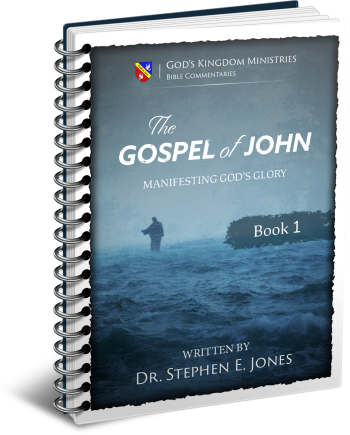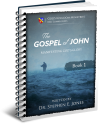Latest Posts
View the latest posts in an easy-to-read list format, with filtering options.

Jesus manifested God's glory through 8 miraculous signs in the gospel of John. These are a revelation of the feast of tabernacles.
Category - Bible Commentaries

Matthew and Luke tell us that after His baptism Jesus went “immediately” (Mark 1:12) into the wilderness, where He was tempted by the devil. John omits that entire story, probably thinking that it was unnecessary to repeat that story. John’s Gospel was written to supplement the other gospels, not simply to repeat them.
The Apostle John tells us about Jesus’ baptism after the fact but does not actually record the event itself. If we look carefully, we see that John speaks of Jesus’ baptism only after He had returned from the wilderness.
Here is the order of events: John had been questioned by the delegation of Pharisees (John 1:19-25). then “the next day” he saw Jesus approaching and said, “Behold the Lamb of God” (John 1:29). It does not say that he baptized Jesus at that moment. Instead, John implies that He had baptized Jesus earlier, saying in John 1:32, “I have seen the Spirit descending as a dove out of heaven, and He remained upon Him.”
John was telling the Pharisees that he had seen the dove upon Jesus, which identified Him as the Messiah. It appears, then, that John was explaining the dove story after Jesus returned from the wilderness. No doubt Jesus had returned to the same Jordan crossing where John was still baptizing. The apostle then continues in John 1:35,
35 Again the next day John was standing with two of his disciples, 36 and he looked upon Jesus as He walked, and said, “Behold, the Lamb of God!”
Likewise, in John 1:43 John tells us that “the next day” Jesus told Philip, “Follow Me.” It is obvious that Jesus had already spent His time in the wilderness and was now back to begin His ministry and to begin gathering disciples.
The apostle omitted the actual account of Jesus’ baptism, preferring to give an account of John’s witness that Jesus was the Christ. The other gospels give the account of Christ’s baptism and trip to the wilderness to be tempted, but the apostle John tells us what happened immediately after He returned from the wilderness.
With that background in mind, let us continue in John 1:37-39,
37 The two disciples [John’s disciples] heard him speak, and they followed Jesus. 38 And Jesus turned, and saw them following, and said to them, “What do you seek?” And they said to Him, “Rabbi (which translated means Teacher), where are You staying?” 39 He said to them, “Come and you will see.” So they came and saw where He was staying; and they stayed with Him that day, for it was about the tenth hour.
Again, we see that Jesus was “staying” somewhere, which implies that He was remaining near Jericho for at least a few days. John implies that Jesus was there to see who would understand the significance of John’s witness that He was the Christ.
It was unusual for the disciples of one Rabbi to switch Rabbis in the middle of training. In fact, under normal circumstances, this would have been a serious breach of protocol. Hence, Jesus did not actively recruit disciples who had been following John. But those two disciples realized that John had deferred to the Messiah, and so they were already prepared to change their allegiance from John to Jesus.
Disciples normally were trained by their Rabbi from the time that they were confirmed by the Bar-Mitzvah at age 12 until they were 30 years old.
John 1:40-42 says,
40 One of the two who heard John speak, and followed Him, was Andrew, Simon Peter’s brother. 41 He found first his own brother Simon and said to him, “We have found the Messiah” (which translated means Christ). 42 He brought him to Jesus. Jesus looked at him and said, “You are Simon the son of John; you shall be called Cephas” (which translated means Peter).
This seems to tell us that Andrew was one of the first two disciples to follow Jesus. He immediately found his brother Simon and told him the good news. When Jesus saw Simon, He renamed him Cephas, which is the Aramaic equivalent of the Greek name Peter (“stone”).
Jesus did not actually tell these disciples to follow Him. It was the disciples who had decided to follow Jesus. Jesus took note of their desire, saying only, “Come, and you will see.” Jesus wanted them to take some time to make such a life-changing decision. He wanted them to observe Him and get to know Him better, so that they could make a more informed decision.
I have found that when Jesus calls us, He normally gives us time to ponder, discern, and pray about it, so that we do not make a hasty decision that we later regret. So also we read in Mark 1:16-18 that Jesus did not tell Andrew and Peter to “Follow Me” until later, while they were fishing in the Sea of Galilee.
We do not know how much time had transpired since they first met Jesus. Luke 5:1-11 gives us a fuller account. This was the occasion where they had been fishing all night with no success. They had returned to shore the next morning, and Jesus used their boat as a platform for teaching.
After teaching the crowd, Jesus told them to go back into the lake and try again. They did so and caught so many fish that the boat was in danger of sinking. That was the occasion, Mark tells us, that Jesus invited them to “Follow Me.” Only then did they officially become Jesus’ disciples.
We are not told explicitly the name of the second of the Baptist’s disciples (in John 1:37) who expressed his desire to follow Jesus. The reason for the silence may be that this disciple was John himself, the author of the gospel, and that he was being modest and anonymous. He often spoke of himself, not by name but as “the disciple whom Jesus loved” (John 21:20) and “the disciple who bears witness of these things” (John 21:24).
If that second disciple is John himself, then perhaps he went to find his brother James, even as Andrew had gone to find his brother Simon. Later, Jesus called James and John while they were repairing their nets on the Sea of Galilee. Jesus called them shortly after telling Andrew and Peter to “Follow Me” (Mark 1:19, 20). But it is quite possible that John and his brother James came to meet Jesus earlier.
Yet there is another possibility as to who that second disciple was. Perhaps it was Philip.
John 1:43, 44 says,
43 The next day He purposed to go forth into Galilee, and He found Philip. And Jesus said to him, “Follow Me.” 44 Now Philip was from Bethsaida, of the city of Andrew and Peter.
Here Jesus walked north to Galilee, where He “found Philip.” This was about a four-day journey, so “the next day” was when Jesus began His trip north to Galilee. We are not told specifically where Jesus met Philip and Nathanael. Their home was in Bethsaida, on the north shore of the Sea of Galilee, but they may have been away from home at the time.
We do not know how He found Philip or what led up to the point where He told Philip to “Follow Me.” Jesus may have met him anywhere along the road from Jericho to Bethsaida.
Philip means “lover of horses.” His Greek name implies that he came from a family of Hellenized Jews from Bethsaida. It was located a few miles northeast of Capernaum, about a mile north of the Sea on the east side of the Jordan River.
Philip’s possible Hellenistic background may also explain why Philip was afterward the first disciple to preach the gospel outside of Judea. He went to Samaria with the gospel in Acts 8:5.
John 1:45, 46 continues,
45 Philip found Nathanael and said to him, “We have found Him of whom Moses in the Law and also the Prophets wrote, Jesus of Nazareth, the son of Joseph.” 46 Nathanael said to him, “Can any good thing come out of Nazareth?” Philip said to him, “Come and see.”
Nazareth was a Jewish outpost on a ridge in Samaria, populated by a radical settler movement that was not so different from the modern Jewish settler movement in Palestinian territory today. John 21:2 tells us that Nathanael was from Cana, located just a few miles north of Nazareth about 14 miles west of Capernaum.
Nathanael’s first reaction was quite negative, showing that he disdained the radical settler mentality. Jesus too disapproved of their narrow nationalism. Shortly after His miracle in nearby Cana, the people of Nazareth invited Jesus to speak at the synagogue, probably hoping to see Him perform a miracle as well (Luke 4:16).
Jesus enraged them by reminding them that “there were many widows in Israel in the days of Elijah… yet Elijah was sent to none of them but only to Zarephath in the land of Sidon” (Luke 4:25, 26). He also told them that “there were many lepers in Israel in the time of Elisha, and none of them was cleansed, but only Naaman the Syrian” (Luke 4:27). The people reacted violently to this message, for we read in Luke 4:28-30,
28 And all in the synagogue were filled with rage as they heard these things; 29 and they rose up and cast Him out of the city, and led Him to the brow of the hill on which their city had been built, in order to throw Him down the cliff. 30 But passing through their midst, He went His way.
Such was the mentality of the ultranationalist people of Nazareth, the city where Jesus was raised. If Jesus had been as radical as His fellow Nazarenes, neither Philip nor Nathanael would have been impressed. When Philip invited Nathanael to see for Himself, Nathanael came only because he trusted his friend. Jesus then proved that He was a prophet, telling him something that no one else could have known.